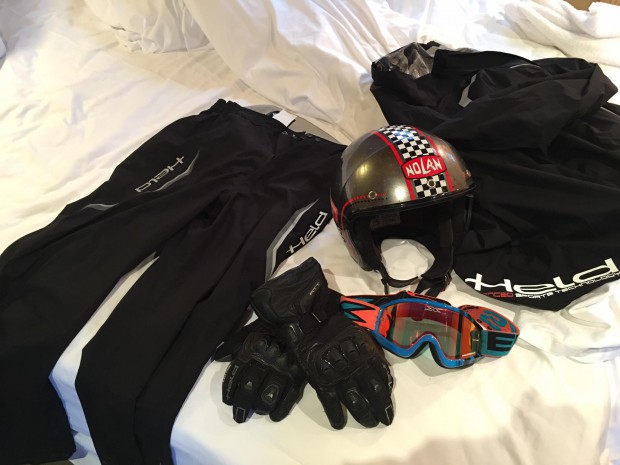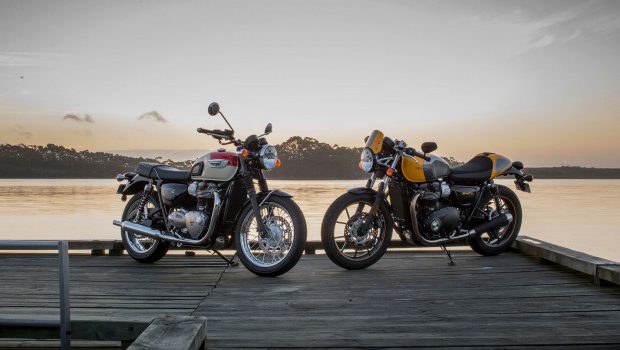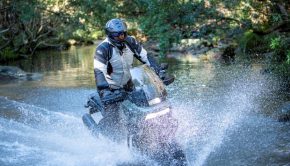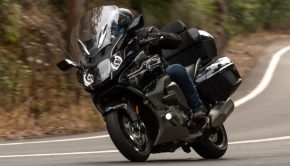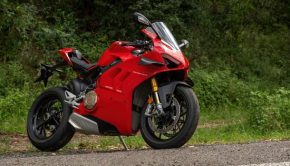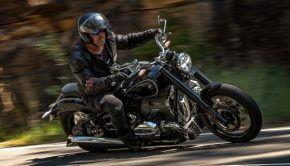2017 TRIUMPH T100 & STREET CUP REVIEW – THE TALE OF THE TWINS
I love discovering new things.
Like the best way to ride Tassy is sporting a colon a-froth with oysters the size of skinned kittens, while astride the new Triumph T100.
Who knew this was even a thing? Happy days.
I had reached Peak Happy on Day Two of a four-day ride through Tassy.
With two more days to go, the timing was perfect.

Bending it not at all like that Beckham fellow.

This is the T100 Black blending into the pine forest.

The other two colour-combos you can have.
Because Peak Happy is not like Peak Drunk.
You get to Peak Drunk and everything is beaut, and in order to maintain that level of beautness you keep drinking. But then it rapidly becomes a case of diminishing returns and police sirens, especially with tequila.
Peak Happy is different. At least for me. I can attain Peak Happy and stay there as long as I keep pumping my brain with stimulants that made me Peak Happy in the first place.
In this case, my Peak Happy had been induced by Tasmania and facilitated by Triumph’s new T100 and Street Cup, both of which I was to ride for two days apiece as part of the Australian Press Launch of the bikes.

There’s just no catching Steve Martin.

We had to throw the snapper very high into the air for this shot.

A great improvment over the Street Twin.
And at the end of the second day, when I rolled into Hobart astride a dusty and hard-used T100, dry-mouthed and gummy-eyed, I was at Peak Happy.
And jammed with oysters. I had eaten many dozens of them in the preceding two days. I planned to eat many more. They were vast, impossibly delicious, and available pretty much everywhere the media pack stopped for food.

This is my Steve Martin impersonation, but heaps slower and with both wheels on the ground.

And this is me doing my Rollie Free impersonation. Also heaps slower and with my clothes on.

A comprehensive dash layout.

We did some of this, for shits and giggles.

And loads and loads of this, for more shits and giggles.
“I cannot eat any more oysters,” Steve Martin whimpered to me at one stage.
“That is because you are weak,” I said over the rim of an oyster shell the size of a child’s face. “That’s what all that international endurance racing and wheelying makes you.”

Steve Martin, not eating oysters.
“You just ordered another dozen, didn’t you?” he said, his mouth a grim dry line, unlike mine which was glistening with the yummy death-juice of Oyster No. 275 in an ongoing series.
I nodded, levering Oyster No.276 into my gullet. “They want us to eat them, Steve. If you’re not eating them, you’re just being rude. And weak.”

You cannot deny it’s a pretty bike.

If you try very hard, yours can float as well.
And clearly not about to attain Peak Happy.
I, on the other hand, was in the zone.
In retrospect, now that the oysters have been voided and the Tassy roads ridden, it was kinda strange to be in that zone.
I had not been riding high-powered, precision-handling sports machines, or naked firebreathers hammered in the forge of torque; the kind of bikes one normally associates with Peak Happy.
I had actually been riding two fraternally-twinned Triumphs – mild mannered and well-handling, lovely to look at, and comfortable to ride – and different, but similar in many ways.

That bloke in the brown outfit is everywhere.
The T100 and the Street Cup are what Triumph views as the 900cc “entry level” bikes to its acclaimed 1200cc T120 Bonneville and Thruxton offerings. And you can read my views on those two jiggers HERE and HERE.
The two variants, 900cc and 1200cc, share the same liquid-cooled, eight-valve, SOHC, 270-degree parallel-twin engine architecture.

The pea-shooter pipes produce a lovely thrum. But it sounds better to a listener than the rider.
The T100 and the T120 share a profile (as does the Street Cup and the Thruxton, but to a slightly lesser degree), but there are some key differences between the models.
Firstly, there’s the displacement – 300cc is 300cc. The big ones just bang harder and the cammed-up Thruxton bangs hardest of them all.
But obviously not everyone wants or needs that kinda bang. Or the price it comes at.

It’s 100km/h. I swear.

And a pretty stress-free riding position.

Adjusting your Gentleman’s Package is simplicity itself.
The T100 has no centre-stand, no grab-rail, no heated grips, and only a single disc up the front (the reduced weight actually makes it turn in a little sweeter than the T120), and while you still get traction control and ABS, you don’t get switchable engine modes.
But with a torque-delivery this smooth (you really need to be hammering hard before you start to feel a bit of a buzz through the bars), and a wonderfully tactile feel to the ride, I didn’t miss that at all. The T100 and Street Cup bang out about 55 horsies and a nice 80Nm of torque at 3230rpm, and while this is not going to win stop-light drags, these are very pleasant numbers to ride astride a machine that weights about 200kg.

It’s totally ravishing.

Fresh off the boat in Hobart.
The gearbox shifts nut-sweet, neutral is easy to find, and the torque-assisted clutch is light and smooth. Good bottom-end torque and perfect fueling means traffic is a breeze – it happily chugs along at 1200rpm in top gear (there are only five gears), so as a daily commuter it’s bang on the money.
The only issue I had was with the fly-by-wire throttle and its refusal to behave like a MotoGP unit and respond in nano-seconds to my crazed inputs on the run from Queenstown to Strahan. I have to admit that I was making demands of it no-one else ever would, and in every universe Steve Martin is always going to be faster than me. But that must never stop a man and his fly-by-wire throttle from trying.

The two colours it comes in. Pity British Racing Green isn’t an option…yet.

The best bar-ends in the business. And crazy handlebars.

Coming to a Devonshire Tea house near you.
Once again, I would clarify that neither bike is at all the kind of motorcycle that one normally associates with hard-charging.
That of course did not stop any of the hard-charging that was going on. And you know something? It’s quite rewarding to be able to ride a motorcycle flat-out. And I rode the T100 and the Street Cup flat out, and it proved to be both joyous and instructive.

Of course it rained.
If I did nothing else apart from load myself with oysters, I rode these two bikes as hard as I could, and came out smiling.
How is this possible on bikes that top-out at just over 160km/h?
Well, there’s the oysters. And then there’s the Tasmanian roads.

Tasmania – endless piles of this.

Slim, like a mugger’s stiletto in the ribs.

Not so slim anymore.
But I’m also thinking another answer is because getting a good pace on comes down to you, the rider. On bikes like the T100, you can’t rely on massive torque and killer horsepower to make up for you being slow in corners. You can’t just twist the throttle after you’ve screwed up a bend and rely on the bike’s power to assuage your shame. Being respectably quick on a T100 or a Street Cup requires determination and unrelenting focus – crucial skills for people who ride motorcycles.
It also helps if the bike handles well, and both of these new Triumphs did not disappoint in that regard. There were times when I had the throttle pinned and was sailing through sweeper after sweeper with a song in my heart and a rock-steady red-lining twin under my belly. There were other times when I was levering it from side to side, over and over, world without end (there are no straight roads in Tassy – just oysters and corners), and working the gearbox like a Yemeni slave, and not once did it startle me or seek to end my life. And that was at the pointy end (and maybe a little on the other side) of its design brief.

“I’m sure if we stay here it will only rain harder…”
I’m pretty sure that no-one who buys a T100 or a Street Cup will ever ride it as hard as some of them were ridden on the press launch, but they can sleep easily knowing just how hard they can indeed be fanged. By oyster-filled professionals, of course.
Neither bike put a tyre wrong though thousands of bends, one whole day of rain, 40km of dirt, and maybe 700 oysters.

“Away with ye, foul tourists!”.

What you can’t see are all the tourists I’m keeping out of the shot.
Triumph is clearly making a habit of building evocative motorcycles. And the past year has been a very good one for the marque in that regard. Its Speed Triple is one of the finest nakeds on the market, and its Tiger is stellar competitor in the tough adventure bike segment.
But it’s in the realm of modern classics that Triumph has really come into its own.
So what’s a ‘modern classic’?

I reckon I’d be fitting the Fox shocks to it.
It’s a marketing term used to describe bikes that look like old-school oil-weepers but thankfully behave like modern motorcycles.
And both the T120 Bonneville and the Thruxton are on-point genre-perfect offerings.
The T100 range has likewise perfectly nailed this modern classic look and combined it with a bike that rides very well, and is therefore a lot of fun to belt around on without going grey from terror.
And I don’t think any other manufacturer has ever or will ever pull this off quite like Triumph’s doing it.
The Japs have tried it, but that Kwaka W800 was only ever trying to look like a Trumpy; as was Yammy’s old XS650.

Strahan Village. Nice place to stay.

No, it’s not the Bridge to Terabithia, unfortunately.
Coventry Triumphs possessed an aesthetic rightness that will always transcend modern motorcycle design, and which is only now being properly resurrected by Hinckley Triumph. Sure, Mr Bloor’s lads have had a few cracks at it in the past, but it’s only this last year that things have really started to gel for them.
The new T120s and T100s look sensational and perform wonderfully well. And it’s interesting to note that in the United Kingdom, the T100 and the Street Cup are available in a Learner Legal form. Which is all kinds of brilliant if you’re 16-years-old, huh?
But even in the form in which I rode them, they would make spectacular Learner’s bikes (as if our owners would ever come to their senses and permit this), or bikes for people who want something that looks splendid, has a great deal of motorcycle integrity in terms of on-road behaviour, but feel they don’t need a bike defined purely by power.

It is the gift that keeps on giving.
The T100 and the Street Cup are as good as bikes get for people like that.
Triumph has indeed had a great 2016, and it looks like it’s going to have an even better 2017.
SO WHAT’S THE DIFFERENCE BETWEEN THE T100 THE STREET CUP?
As I said earlier, these are fraternal twins. They are identical in many ways, and different in a few others.
Aesthetically, the T100 is, for all intents and purposes, a smaller capacity Bonneville T120. The Street Cup on the other hand is more a café-racered T100 than it is a Thruxton with a smaller engine.

Same but different.
It shares the Thruxton’s instrument cluster and foot-pegs, and the T100’s petrol tank, but in keeping with its more café-racery schtick, comes with a rear-seat cowl, shorter pipes, a different seat and drop-bars. It also has slightly longer rear shocks, which cant the bike and you forward in a slightly more aggressive posture, perfectly in keeping with the Street Cup’s game. It also has cast wheels rather than the spokes gracing the T100, which I prefer, but then manufacturers don’t build bikes to please me alone, more’s the pity.
The Street Cup’s seat is firmer than the T100s, has contrasting hand-applied stitching and is made from wild Alcantara pelts (like the Thruxton) and the best bar-ends ever made (also like the Thruxton).

For three days it was like this…

…and then it was like this.
I preferred the Street Cup to the T100. The riding position made it (and me) more disposed to motorcycle neck-wringing. And I didn’t find it was uncomfortable despite the lower handlebars. Humans taller than six-four on the old scale with giraffe-like legs and elongated torsos might think differently, but why should anyone build bikes for the deformed?
I think it is stunning to look upon – especially in silver. I liked the hell out of it in yellow, but the silver was just special. They’re the only two colours it comes in.
Unlike the T100. That you can have in white with a blue tank flash, white with an orange tank flash, or black. There is also a T100 Black which comes in either matte or gloss variations of heaps more blackness. Happily none of them come with a brown seat.
The Street Cup’s got some small aesthetic glops like the wiring I can see between the seat and the frame, but as a complete package, it is quite one of the prettiest bikes on the market. Especially when you trick it up with some Vance & Hines cans and Fox piggy-back rear shocks you can get through the Triumph aftermarket catalogue.
In fact, there’s a whole bunch of post-buy goodies available for both the T100 and the Street Cup, and Triumph did build them with that kind of customisation in mind.

At the start of the 99 Bends road just outside of Queenstown.
HOW MUCH?
The T100 $15, 300 plus ORC
The T100 Black $15,500 plus ORC
The Street Cup $15,300 plus ORC
TECHNICAL STUFF
You may examine all the specs for the Street Cup HERE and the T100 HERE.
PHOTOGRAPHY BY DEAN WALTERS
THE ROUTE
Tasmania is stunning. You all know that, even if you’ve never been there. Do it fast for the roads, do it slow for the scenery, or do a bit of both, but do it. You will never regret it. I rode it for four days and while I drank deeply from the Well of Glorious Bitumen, it was still only a taste of what Tassy offers.
We kicked off on the T100 from Barnbougle Dunes near Bridport and headed for St Helens via Derby and Pyengana, which was mainly fast sweepers, finalised by some technical hairpins and killer views.

Obligatory Scenery Shot No.1. Freycinet rocks.
Then we turned south and hugged the coast through Scamander and St Mary’s, before flinging ourselves inland and down the notoriously brilliant and challenging Elephant Pass, which regularly eats the four-wheeled competitors of the Targa Tasmania. But it was just another place for Steve Martin and Trevor Hedge to do wheelies.
Back on the coast, we headed through Bicheno and chucked a left towards Coles Bay, where fast sweepers and rude car-drivers encouraged me to ride like I meant it. We stayed the night at Freycinet Lodge, where I consumed enough beer to make the sunset romantic.
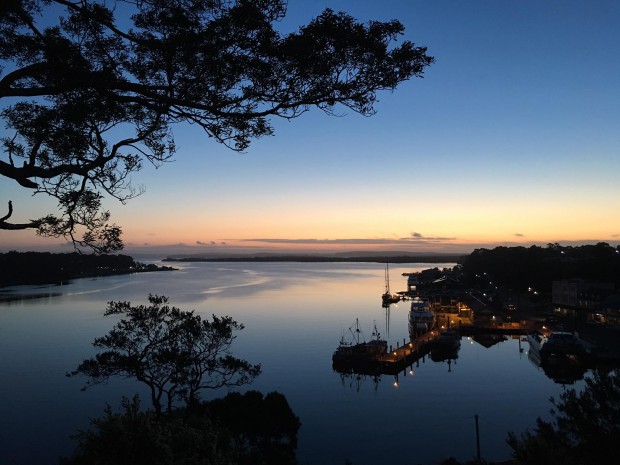
Obligatory Scenery Shot No.2 Looking down on Strahan.
The next morning we made our way back along the Freycinet Peninsula, chucked a left and headed further south down the east coast of Tassy, through Swansea, Orford and Buckland. We made a slight detour so that I could ram more oysters down my neck at the Bangor Wine and Oyster Shed near Dunally, before sliding into Hobart for the evening.
The next morning we were on Street Cups and heading northwest along the Derwent River. The run through New Norfolk, Hamilton and Ouse was good, but as we approached the vast Franklin-Gordon Wild Rivers National Park, it became spectacular. Overwhelmingly so. This was the Lyell Highway. At times I wasn’t sure if I should be looking at the scenery or hammering the bends. It was very hard to do both, so I would alternate. We stopped somewhere before Lake Burbury and then again in Gormanston, allegedly to take refreshment. I just walked around in circles muttering to myself, which is what I do when I try and rationalise the endless pro-cambered corners, lack of cars and total absence of Highway Patrol.

Obligatory Scenery Shot No.3. Coles Bay.
And then it got better. The run up and then down into Queenstown through the so-called 99 Bends was ninja-level shit.
And then it got better again. Somehow.
From Queenstown to Strahan the road is an evil snake-winding stretch of smooth, grippy bitumen that simply demands to be ridden with venom.
If such a stretch of road existed on the mainland, the police would jail every rider who rode upon it, then have it bulldozed.
When I finally pulled up in Strahan, I was spent. Glass-eyed with bend-fever, I adjourned to the local pub to drink quietly and wonder if it would be possible to tow this whole island north, so that it sat just off the coast of Wollongong.

Obligatory Scenery Shot No.4. River full of fish.
The next morning it was raining, which happens quite a bit in Tassy, but I had heard the bitumen is still pretty grippy in the wet. This proved to be the case, and we retraced our tyre-tracks back up the same superb road we had come in on the day before, then went looking for Cradle Mountain.
Interestingly, it was even a bit cold at this stage, but the roads began to dry out on our approach to the mountain, and pretty soon the weather didn’t matter, because beholding Cradle Mountain simply empties your brain of all other rubbish. It is very special, but it is very touristy, so don’t think you’re going to have it all to yourself.
From there, we made our way back to Launceston via Sheffield, Elizabeth Town and Deloraine. We even managed to jam in a few kilometres of freeway towards the end.
Here it is on the Interwebs
A BEAUT VIDEO SHOT BY TRIUMPH
MY GEAR

Helmet – Nolan N21. One of the best open-face lids I have ever worn. My review of it is HERE.
Goggles – EKS. Crazy orange bastards. Love them to bits. I wore these on the second-half of the launch because they work well in the rain. The review is HERE.
Other goggles – Scott Safari. I wore this goggs-and-face-shield combo on the first half of the launch. I would have kept wearing them, because they are a good thing, but we needed a different look for a different bike. My review is HERE.
Wet-weather gear – Rainblock. This is the Held top ($150) and bottom ($130) that saw me through Europe. This is next-level wet-weather gear. Easy on and easy off, even on the side of the road, and made out of some bizarre rubbery stuff they probably make superhero outfits from. But it works and it is pretty robust. It also folds away into a very tiny package. The review is forthcoming.
Gloves – Held Air’n’Dry. I have been praising these to the sky. I have had them for a year now and they are pretty much the only gloves I wear and perfect for the changeable weather in Tassy. Great in summer and great in almost-winter. The review is HERE.
Pants. these were also Held items which I scored in Europe. They are cargo pants with lots of pockets and armoured knees. They are comfortable and appear to be made from waxed cotton. They have worn very well over more than 5000km, and are cool enough in summer, and just as good with thermals under them in winter. The full review is to come.
You can get all the Held gear HERE.
Boots – Falco Shiro. This is my second pair. An all day every day short boot which you can dance in if you have to. Sadly not waterproof. But very stylish. I even have a new pair I’m going to put on very soon. Each pair lasts me about 18 months and they are worn virtually every day. The review is HERE.
